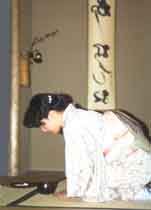|
Japanese Tea Ceremony
 At
its most basic level, the Japanese tea ceremony is about gathering with friends to
enjoy a bowl of tea. Participants enjoy pleasant conversation about
seasonal beauty and art objects displayed in the Japanese tea house.
They might comment on the freshness of the tea garden or the attractiveness
of a particular Japanese tea cup. And of course they will all enjoy
drinking the matcha green tea prepared by their host.
At
its most basic level, the Japanese tea ceremony is about gathering with friends to
enjoy a bowl of tea. Participants enjoy pleasant conversation about
seasonal beauty and art objects displayed in the Japanese tea house.
They might comment on the freshness of the tea garden or the attractiveness
of a particular Japanese tea cup. And of course they will all enjoy
drinking the matcha green tea prepared by their host.
In Japan, however, the tea ceremony - also known as chanoyu - is much more than a simple tea party. It is an aesthetic, almost spiritual, experience. Tea gatherings are held in exquisite tea houses or Japanese homes that are surrounded by beautiful gardens. The stepping stone path up the the tearoom is lovingly cared for. And the Japanese carpentry seen in the teahouse is of the absolute highest quality. All of these visual details help to create a magical setting that is just as important as the Japanese tea, itself.
One of the participants will act as the host. Before the event he or she will carefully select the artwork to be displayed and the Japanese tea cups that will be used. Her goal is to create the perfect atmosphere for the guests. In Japanese, that perfect atmosphere is summed up by the phrase wa-kei-sei-jaku, which means "Harmony, Reverence, Purity, and Tranquility." The guests, in turn, will do their best to support the tea philosophy of Ichigo Ichi-e, which means "We only have one chance to enjoy this present moment. Let's do our best."
The Japanese tea ceremony thus becomes more than just a gathering of friends. It is a cultural aesthetic and a cultural attitude that is extremely influential in Japanese culture. JOJG is happy to publish at least one article per year about the Japanese tea ceremony and Japanese green tea. Posted below are a few articles for review:
--------------------------------------
THE MOOD OF TEA This article by Kathleen Fink examines the atmosphere of the Japanese tea ceremony. The core values of Japanese tea involve sharing a bowl of tea with a few friends. Along the way guests learn to appreciate subtleties of mood such as the changing seasons, the beauty of a Japanese tea cup, and the earthy taste of matcha green tea.
HEATING WATER FOR TEA This article examines the intricate care and detail that goes into just one small aspect of chanoyu. By looking at the seemingly mundane process of heating water we can appreciate the care that goes into the whole.
JAPAN TEA CEREMONY This article is a short summary of what the tea plant and the tea ceremony mean to Japanese culture.
SHIGENARI FURUTA This is a biography of one of Japan's great tea masters. Also known as "Oribe," he was influential in creating a lighter, more relaxed tea aesthetic.
BENEFITS OF GREEN TEA There's more to chanoyu than just friendship and aesthetics. This article discusses specific health benefits derived from drinking Japanese teas.
---------------------------------------